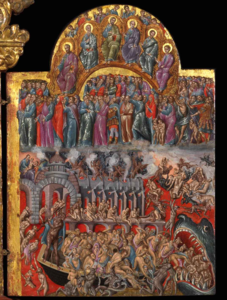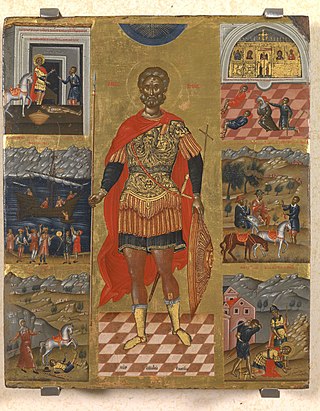
Cretan School describes an important school of icon painting, under the umbrella of post-Byzantine art, which flourished while Crete was under Venetian rule during the Late Middle Ages, reaching its climax after the Fall of Constantinople, becoming the central force in Greek painting during the 15th, 16th and 17th centuries. The Cretan artists developed a particular style of painting under the influence of both Eastern and Western artistic traditions and movements; the most famous product of the school, El Greco, was the most successful of the many artists who tried to build a career in Western Europe, and also the one who left the Byzantine style farthest behind him in his later career.
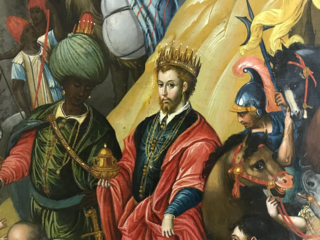
Michael Damaskenos or Michail Damaskenos was a leading post-Byzantine Cretan painter. He is a major representative of the Cretan School of painting that flourished in the 16th and 17th centuries. Painters Georgios Klontzas and Damaskenos were major contributors to the Cretan School during the same period. Damaskinos traveled all over the Venetian Empire painting. He remained loyal to his Greek roots stylistically but incorporated some Italian elements in his work. He was strongly influenced by the Venetian school. He painted parts of the Cathedral of San Giorgio dei Greci. Damaskenos has 100 known works. He influenced the works of Theodore Poulakis.
The Last Judgment is part of the eschatology of the Abrahamic religions and in the Frashokereti of Zoroastrianism.

Emmanuel Tzanes, also known as BounialisEmmanuel Tzane-Bounialis, Emmanuel Zane, and Emmanuel Tzane, was a Greek Renaissance painter, author, clergyman, and educator. He spent the latter half of his life in Venice, where he was parish priest of the church of San Giorgio dei Greci and a member of the Flanginian School run by the city's Greek Confraternity. Tzanes painted in the style of the Cretan School, influenced by contemporary trends in Venetian painting. His known extant works, over 130 in number, can be found in public foundations, private collections, churches and monasteries in Greece. The most popular of these is The Holy Towel, finished in 1659. Tzanes was a collaborator with Philotheos Skoufos, and brothers with the painter Konstantinos Tzanes and the poet Marinos Tzanes.

Theodore Poulakis was a Greek Renaissance painter and teacher. He is considered the father of the Heptanese School and one of the most prolific painters of Venetian Crete. Poulakis was a member of the Cretan School, his contemporary was Emmanuel Tzanes. Emmanuel Tzanes and Poulakis were active painters of the Cretan School until Candia, went to war with the Ottomans around 1649. Candia finally fell after twenty years of siege in 1669. Poulakis settled on the island of Corfu. Stephanos Tzangarolas was another famous painter in Corfu around the same period. Poulakis's works are likened to Andreas Pavias and Georgios Klontzas. Poulakis works exhibit qualities of the Venetian school. Over 130 of his paintings have survived and can be found all over the world.

Andreas Ritzos also known as (Andreas Rico, Ricio or Rizo) was a Greek icon painter from Crete. Ritzos is considered one of the founding fathers of the Cretan School. He was affiliated with Angelos Akotantos. Most of his work stylistically follows the traditional maniera greca. His children, grandchildren, and great-grandchildren were also painters. He was one of the most influential painters of the Cretan School along with Andreas Pavias and Angelos Akotantos. He influenced the works of Georgios Klontzas, Nikolaos Tzafouris, Theophanes the Cretan, Michael Damaskinos and El Greco. According to the Institute for Neohellenic Research, sixty of his paintings have survived.

Georgios Klontzas also known as George Klontzas and Zorzi Cloza dito Cristianopullo. He was a scholar, painter, and manuscript illuminator. He is one of the most influential artists of the post-Byzantine period. He defined the Cretan Renaissance. He worked for both Catholic and Orthodox patrons. His artistic output included: icons, miniatures, triptychs, and illuminated manuscripts. He is known for occupying his icons with countless figures. The technique is extremely complex and unique to Klontzas. Andreas Pavias attempted this technique in the Crucifixion of Jesus. Klontzas's painting All Creation rejoices in thee is his most popular work. Klontzas influenced Theodore Poulakis he created an extremely similar painting called In Thee Rejoiceth. Klontzas's work is strongly influenced by the Venetian school. His triptychs strongly resemble the works of Gentile da Fabriano, namely the Intercession Altarpiece. Klontzas's Last Judgement resembles Michelangelo's Last Judgement in the Sistine Chapel. There are very close similarities. There is no indication that Klontzas saw the work but it is a possibility. According to the Institute of Neohellenic Research fifty-four items of his art exist today.

Frantzeskos or Franghias Kavertzas was a Greek painter. His painting style resembles the late Cretan School or early Greek Baroque period. His work was influenced by Georgios Klontzas, Michael Damaskinos and Emmanuel Tzanfournaris. He was active in Crete during the early part of the 17th century roughly after the death of Georgios Klontzas. He painted two icons that are very similar to Klontzas's most notable pieces. Theodore Poulakis also painted similar themes. Kavertzas artwork incorporates the Venetian school. His works influenced Leos Moskos. His most notable works are the Last Judgement, In You Rejoiceth.

Ιoannis Apakas, also known as Johann Apakass was a Greek painter and priest. He was active in the latter part of the 16th century to the early 17th century. He was popular artist during his time.

Leo or Leos Moskos was a painter and educator. There were two other painters named Moskos active around the same period, Elias Moskos and Ioannis Moskos, who may have been his relatives. Indeed, Leo is often confused with Elias Moskos. Some of his work was inspired by Georgios Klontzas and Franghias Kavertzas. He traveled all over the Venetian Empire. Records indicate he traveled to Venice, Cephalonia, and Zakynthos His style resembled the Cretan School. He taught famous painter Panagiotis Doxaras. His most popular work is the Last Judgment. His paintings can be found all over the world. Twenty of his paintings have survived.

In Thee Rejoiceth also known as Epi Si Harri is a tempera and gold leaf painting by Georgios Klontzas. The painting is a tribute to the Virgin Mary. Klontzas was active on the island of Crete during the second half of the 16th century. He was a member of the Cretan School. He was one of the most prolific Greek painters of the 16th century. Most of his works were copied by other artists. The In Thee Rejoiceth painting was copied by countless Greek and Italian painters. Theodore Poulakis created a version in the 17 century that is very similar to Klontzas's In Thee Rejoiceth. Franghias Kavertzas also painted a similar theme. He called his painting In You Rejoices. Leos Moskos also created his version of the popular painting. The Klontzas painting is currently at the Hellenic Institute of Byzantine and Post-Byzantine Studies Museum in Venice.

In Thee Rejoiceth also known as Epi Si Harri is a tempera and gold leaf painting by Theodore Poulakis. The central figure of the piece is the Virgin Mary. The painting is a tribute to her. Poulakis was from Chania Crete. He was active on the Ionian islands and in Venice during the second half of the 17th century. He was a member of the Cretan School and the father of the Heptanese School. According to the Institute of Neohellenic Research, 130 paintings are attributed to Poulakis.

The Last Judgment also known as The Second Coming is an icon by Georgios Klontzas. The painting is a depiction of the return of Jesus Christ. The Second Coming is believed to be the final and infinite judgment by God of the people of every nation resulting in the approval of some and the penalizing of others. This painting is a depiction of that event. Klontzas was a Greek artist from the island of Crete. His artistic output was during the second half of the 16th century. He was affiliated with the early works of El Greco. He was one of the most productive Greek painters of the 16th century along with Michael Damaskinos. Klontzas was a member of the Cretan School. Most of his works were copied by other artists. His version of the Second Coming was used as a framework for other artists during the Late Cretan School. Leos Moskos and Francheskos Kavertzas both created similar versions.

The Last Judgment also known as The Second Coming is an egg tempera painting by Francheskos Kavertzas. His artistic period was during the first part of the 17th century. Seven of his works survived, five were signed. He was a member of the late Cretan School. The Last Judgment painted by Georgios Klontzas inspired countless Cretan artists, Kavertzas was one of them. Kavertzas's painting In You Rejoiceth strongly resembles Klontzas's In Thee Rejoiceth. Leos Moskos was also inspired by Klontzas's work. He also painted a similar version of The Last Judgment. The final judgment is the last judgment of every person on earth. The painting is a pictural representation of that event. The Kavertzas The Last Judgment is unique because it features a nun. Her name was Evgenia Trapezontiopoulla. According to records on March 9, 1641, the nun could not afford to pay for the painting. Kavertzas and the nun bartered instead. The painting is part of the collection of the Hellenic Institute of Venice in Italy.

The Last Judgment also known as the Second Coming is a painting by Leos Moskos. His artistic legacy was during the 17th century. Twenty of his paintings survived. He shared the same last name as Elias Moskos and Ioannis Moskos, they may have been related. All three painters flourished during the same period. Moskos worked all over Europe namely, Crete, Zakynthos, and Venice. His student was famous painter Nikolaos Doxaras.
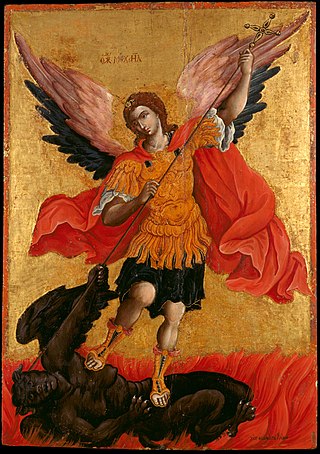
The Archangel Michael was created by Greek painter Theodore Poulakis. He was also a teacher. He was affiliated with Greek painter Philotheos Skoufos. Poulakis was active on the Ionian Islands and Venice. He studied painting in Venice for over a decade. He was also involved with Venetian politics. He was a member of the quarantia. He was a representative of two schools, the Cretan School and Heptanese School. He is considered one of the founding members of the Heptanese School along with Elias Moskos. One hundred thirty of his paintings survived.
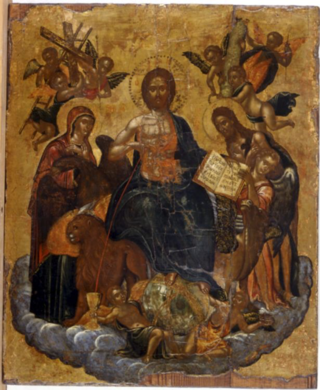
Tribute to the Eucharist was a painting made of egg tempera and gold leaf on a wood panel. The portable icon is attributed to Greek painter Michael Damaskinos. Damaskino's existing catalog features over 100 known works. He was a member of the Cretan school of painting. He was from the island of Crete. His contemporaries were Georgios Klontzas and El Greco. Damaskinos traveled all over Italy for over twenty years. He spent a significant amount of time in Venice. He adopted Italian mannerisms. He applied these new attributes to his paintings. He was friends with sculptor Alessandro Vittoria. He had a collection of drawings obtained from other Italian artists. Namely the Mannerist Parmigianino. He was also exposed to the magnificent works of Italian painter Raphael.

The Incredulity of Saint Thomas is a tempera painting created by Greek painter Emmanuel Tzanes. Tzanes features a catalog of artwork numbering over one hundred works. He was one of the most prolific artists of the 1600s painting in Crete, Corfu, and Venice. His two brothers Marinos Tzanes and Konstantinos Tzanes were also famous painters but Marinos is more well known for his famous poem The Cretan War Ο Κρητικός Πόλεμος. All three artists were members of the Late Cretan School and early Heptanese School (painting) they were known for participating in the movement that integrated Flemish engravings into the Greek and Italian art world.

Transfiguration and Monastic Scenes is a multi-themed tempera painting created by Greek painter Georgios Klontzas. Klontzas was a Cretan Renaissance painter. The artist was hired to assess work completed by El Greco. Klontzas was from a wealthy family and owned a successful workshop in the center of Crete. His existing catalog consists of Fifty-four works. He completed incredible triptychs and manuscripts. Klontzas and Micheal Damaskinos are two of the most prominent Greek painters of the 16th century due to the size of their catalogs and the popularity of their works excluding El Greco.

Triptych of the Last Judgement is a tempera-painted triptych created by Cretan Renaissance painter Georgios Klontzas. Klontzas was active in Crete during the later part of the 16th century. El Greco was active around the same period and was also from Crete. Klontzas was hired to assess his work. Klontzas completed tempera paintings, triptychs, and illuminated manuscripts. His existing catalog comprises over fifty-four pieces of his art. Klontzas frequently painted the theme of the Last Judgment. Some of his well-known works include The Last Judgement Triptych (Klontzas) and The Last Judgment (Klontzas). The Vatican owns Triptych of the Just in Glory also created by Klontzas which also features the Last Judgment.





